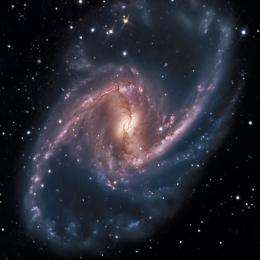Mysterious X-rays from a Nearby Galaxy

(PhysOrg.com) -- The nucleus of an active galaxy, an AGN, contains a massive black hole that is vigorously accreting material. In the process it typically ejects jets of particles and radiates brightly at many wavelengths, in particular at X-ray wavelengths.
It turns out that nearly half of all AGN seem to have very thick gas clouds near their nuclei, a conclusion reached because only high energy X-rays are seen coming from them; the usual explanation is that gas clouds absorb the lower energy X-ray emission, while higher energy radiation is relatively unaffected.
X-ray AGN are important to astronomers not only because they provide new insights into black holes and their surroundings, but because the X-rays are often time variable, suggesting that these clouds of gas are in motion around the nucleus. These kinematics in turn provide information on how the AGN and its galaxy formed and evolved.
The galaxy NGC 1365 is about sixty light-years away. It is notable for having rapid variations in its low energy X-rays -- timescales of just days, suggesting that solar-system-sized gas clouds near the nucleus are moving across our view of the AGN, possibly part of a torus around the nucleus. SAO astronomers Guido Risaliti, Martin Elvis, Pepi Fabbiano, and Junfeng Wang have used a suite of orbiting X-ray telescopes to discover and track a very curious property of NGC 1365: its high energy X-ray emission is about twice that expected compared to the low energy emission, even when the low energy radiation is at its brightest.
The scientists offer three possible explanations for this so-far unique situation: the AGN has yet another layer of absorbing gas but one that does not vary (but where did it come from), there is a second black hole contributing its own X-rays (but no other galaxy of this type has two such black holes), or the shape of the absorber has a particular, complex geometry (which seems very artificial). Whatever the final solution, the new paper sheds light on the complex environment that can exist around active galactic nuclei.
Provided by Harvard-Smithsonian Center for Astrophysics (news : web)





















